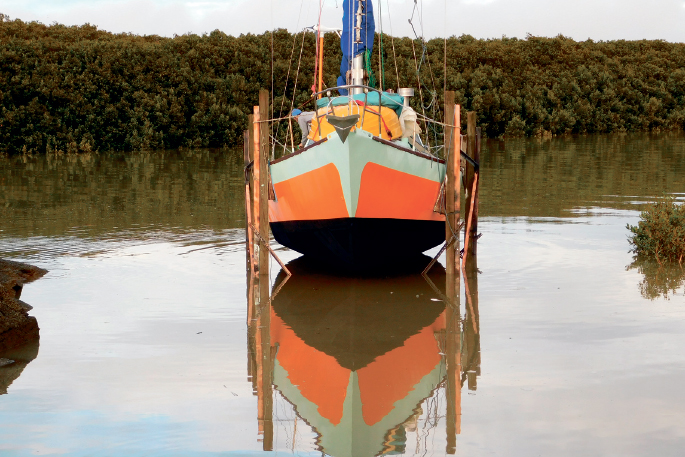The latest developments in anti-fouling are re-writing the rules about anti-fouling coatings, how they work and how they are applied. For decades, anti-fouling coatings’ efficacy has been measured by how toxic the brew is – how many marine species will die before the toxicity declines to the point where they begin to gain a foothold on the hull? Former generations liberally swathed their hulls in smelly concoctions wearing shorts and jandals. Nowadays they’ve been replaced by hooded paint suits, fume masks and rubber gloves. But the latest step in anti-fouling coatings may be about to set the health and safety clock back. There’s two of the new systems being sold in New Zealand, both offering five years or more, compared with the standard two-year life time of anti-fouling paints. They are both based on adhesive films stuck to the hulls. They are Micanti Antifoul, and Hamilton-based Marine Protection Solutions. Former Tauranga-based charter operator Simon Hamer is the New Zealand agent for Micanti, operating as Antifoul Alternatives Ltd. Marine Protection Solutions is operating out of Hamilton, with Glenn and Mitchell Clough as directors. Micanti antifoul is a self-adhesive film applied to the hull, not a paint, and is sold with a guaranteed life of five years. The system is a nylon fibre, polyester film and a two component water-based adhesive. Dr Rik Breur, from the Delft University of Technology, found that marine species such as mussels and barnacles always need a certain open area to settle. By creating a surface of micro fibres, this settlement is prevented. The first vessel in New Zealand to install Micanti is ‘Soundsgood’ - a 34ft steel Ganley owned by Etienne Messikommer. “I am intending to sail ‘Soundsgood’ around the world and the last thing I want is to leave a trail of toxic waste in my wake,” says Etienne, “so when I was introduced to Micanti Antifoul I was immediately enthusiastic.” However, a product such as an antifouling system has to also be effective as well as environmentally friendly, particularly for a vessel intending such a long voyage. The terms non-toxic and antifouling would appear to be contradictory, but Micanti is effective against marine organisms due to its physical, rather than its chemical characteristics. It consists of a microfibre of nylon hairs that organisms simply cannot adhere to. It is supplied in a roll of self-adhesive material that can be applied safely and without any environmental issues, either by the boat owner or by approved applicators. The second vessel to have the product applied is Simon’s 18m sailing catamaran ‘South Sea Vagabond’, currently sailing a charter operation in Vanuatu. Simon says she will be an ideal test bed for the product, clocking up several thousand nautical miles in a variety of conditions and waters, before returning to New Zealand in December for the cyclone season. Marine Protection Solutions has test boats at marinas around the country, including on Bridge Marina Travel Lift director Bruce Goodchap’s yacht Redline. “We’ve got two different types,” says Mitchell. “We have got a flow fouling, which is a flocking type film similar to what Simon Hamer has, and we’ve also got a high performance silicon which is what is on Bruce’s boat.” The high performance film lasts up to five years and boasts nine per cent less friction in the water at 20 knots than conventional anti fouling. It self-cleans at eight knots or can be chamois washed or with a light water blasting. “We’ve had samples in marinas around the country for up to 15 months now,” adds Mitchell. “The longest in Opua as a static test still has hardly any growth on it. These are European films that have been in Europe for the last six or so years.” As an alternative, it’s not for every boat. Caulked planked hulls are out, but splined and glassed is okay. Hulls that do over 40 knots are also out - not that there’s many of them about. The Marine Protection Solutions film is applied only by certified installers at this point. “It’s not an easy job to apply. It’s like vinyl wrapping - you can’t just pick up a squeegee and a heat gun and do a vinyl wrap on a boat or a car,” says Mitchell. “It’s not like picking up a paint brush. There’s a fair bit to it and you have to make sure the application has got to be as good as you can get it, because if there is an area on there you are not confident about then it’s probably going to come back and bite you.” Previous anti-fouling has to be removed and the hull re-primed. The wrap goes over the top of Interlux Primocon or International Interprotect as a tie coat. For more information visit https://nzmps.co.nz/ and
www.micanti.com, or email antifoulalternatives@gmail.com
Saturday, December 20, 2025
Posted: 10:56am Tuesday 19 Dec, 2017 | By Andrew Campbell andrew@thesun.co.nz
New non-toxic anti-fouling

The first vessel in New Zealand to install Micanti antifoul wrap is Etienne Messikommer’s 34ft steel Ganley ‘Soundsgood’ – here re-entering the water.


0 Comments
Leave a Comment